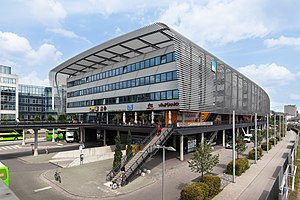Central bus station in Munich
| Central bus station in Munich | |
|---|---|
 The ZOB Munich from hackers bridge seen from
|
|
| Data | |
| Bus platforms | 29 |
| opening | September 11, 2009 |
| Website URL | https://www.muenchen-zob.de/de |
| location | |
| city | Munich |
| country | Bavaria |
| Country | Germany |
| Coordinates | 48 ° 8 ′ 33 ″ N , 11 ° 33 ′ 0 ″ E |
The Central Bus Station (ZOB) Munich is the largest bus station in Munich and one of the most modern bus stations in Germany. In addition to its role as the central hub for national and international long-distance bus traffic , it also serves as a shopping center .
Location and description
The central bus station was opened on September 11, 2009 and is located in the immediate vicinity of the Hackerbrücke S-Bahn station and not far from Munich Central Station . The Hackerbrücke , located right next door, is connected to the bus station building via two bridges. In the immediate vicinity is the Arnulfpark , a modern urban quarter with residential and office buildings, cultural institutions and restaurants.
The ZOB was designed as a multifunctional property with a floor space of around 25,000 m², seven floors and different levels of use. The bus station, which is located below the ground floor, is accessible via Arnulfstrasse and has 29 stops where national and international long-distance bus services and a large part of Munich's tourist bus traffic are handled. Travelers use escalators or elevators to get to the first floor, where the shopping arcade with retail and catering areas is located, giving the central bus station an airport-like character. Tenants on the upper floor are, for example, Lidl , dm , McDonald’s , TUI and Vapiano . On three further upper floors and around 10,300 m² of space there is office space, as well as a parking deck and a discotheque in the basement .
architecture
After a public invitation to tender by the city of Munich in 2002, the contract for the design was handed over to the architectural office Auer + Weber + Assoziierte . The futuristic exterior facade is modeled on the shape of an ICE powered end car , which was supposed to fit in with a redesign of Munich Central Station , which was discussed at the time . Almost 31 km of tubes were used for the aluminum tube design, which is unique in Germany .
Operation of the bus station
owner
In 2014, the ZOB was acquired by the Munich issuing house WealthCap , the previous owner was the project developer Hochtief . The bus station is operated by the Bavarian Red Cross .
Users
The bus station is mainly used by numerous long-distance bus providers , but also tour operators . Buses from companies such as Flixbus or IC Bus , which offer national and international connections, regularly go to the ZOB. City buses are excluded from this, as the public connection is via the Munich S-Bahn and tram .
fees
Buses that drive to the central bus station paid 6.00 euros for half an hour and 11.00 euros for a full hour's stay at the opening. In 2018 the prices were 8.00 and 11.00 euros. In addition, there are other price graduations up to 56.00 euros for the maximum permitted parking time of 24 hours.
criticism
The premises above the bus stops were criticized for a number of years because they were initially unsatisfactory for tenants. When the bus station opened, only six of the 17 rental spaces could be let. Due to the low customer frequency of only 1,500 people per day compared to the planned 8,000 to 10,000, several tenants cut their payments to the project developer Hochtief in 2011 , whereupon Hochtief filed a lawsuit. In 2013, the District Court of Munich I ruled in favor of a tenant in a first case.
As a result of the deregulation of the long-distance bus market in Germany, there was a significant improvement in the use of the central bus station from the beginning of 2013. The average number of arrivals and departures increased from 80 buses per day in 2010 to 135 per day in 2013. When the bus station opened, 42,000 buses per year, an average of 115 buses per day, were expected.
Web links
Media reports
- Dominik Hutter: The spaceship will soon be ready to go , August 21, 2008, sueddeutsche.de
- ZOB photo gallery on www.merkur-online.de
Individual evidence
- ↑ A bus station with the character of an airport . Augsburger Allgemeine Zeitung September 18, 2007.
- ↑ WealthCap completes Munich portfolio , finanzwelt.de of August 4, 2014, accessed on November 11, 2016.
- ^ City of Munich: Central bus station in Munich (ZOB). Retrieved March 3, 2015 .
- ↑ a b Münchner Merkur: “Empty switches at the new bus station” , August 31, 2009, accessed on May 2, 2013.
- ↑ Price information on the official website of the ZOB Munich , accessed on September 1, 2018.
- ^ Süddeutsche: “Fahrt ins Leere” , January 24, 2013, accessed on May 2, 2013.
- ↑ Abendzeitung: “Bargain hunters now go by bus” , April 19, 2013, accessed on May 2, 2013.
- ↑ a b Münchner Merkur: "Busse avoid the bus station" , September 8, 2010, accessed on May 2, 2013.
